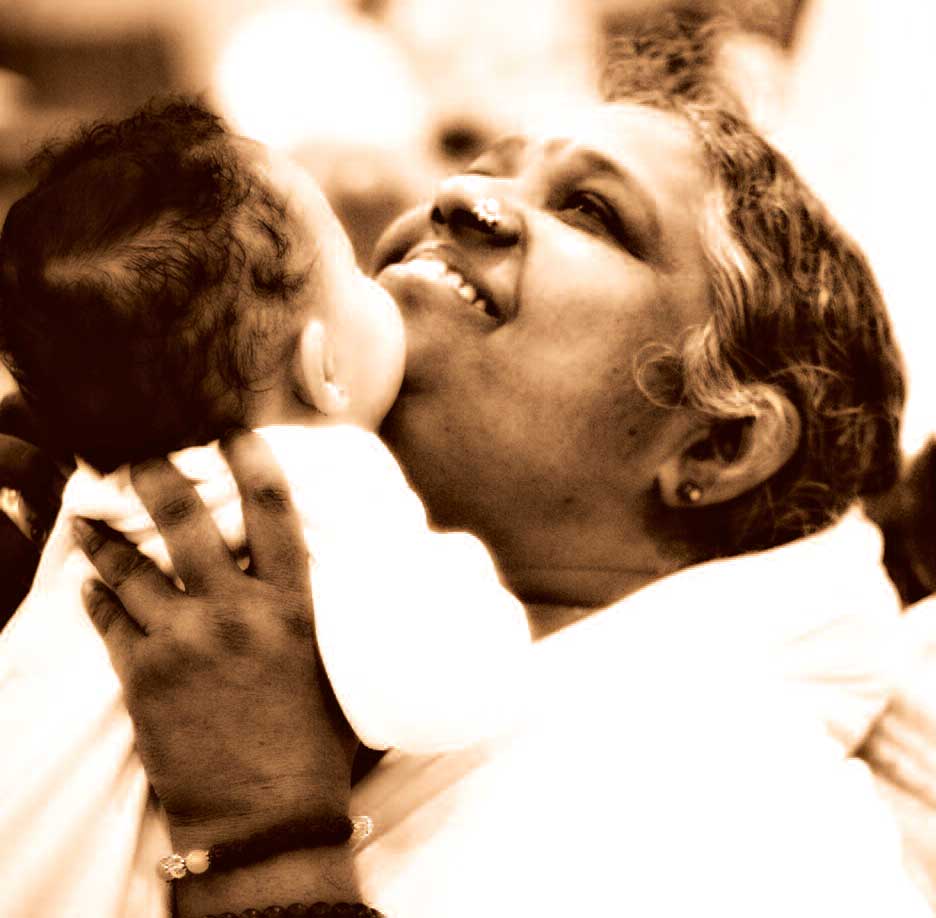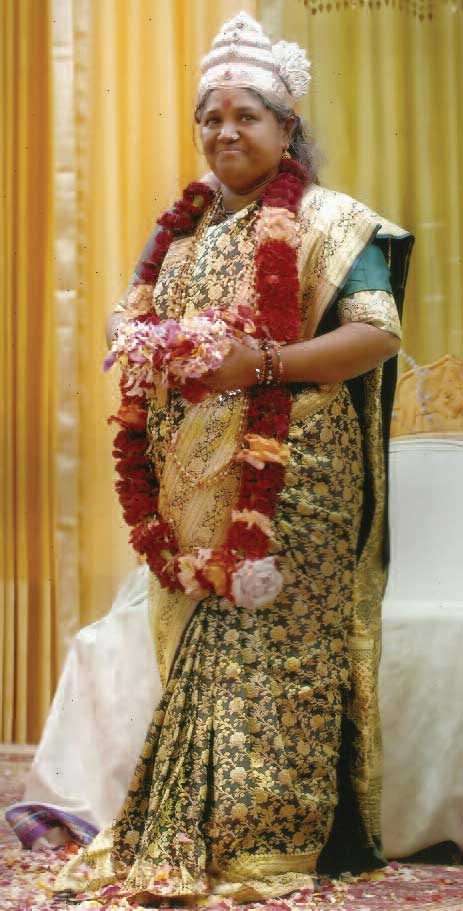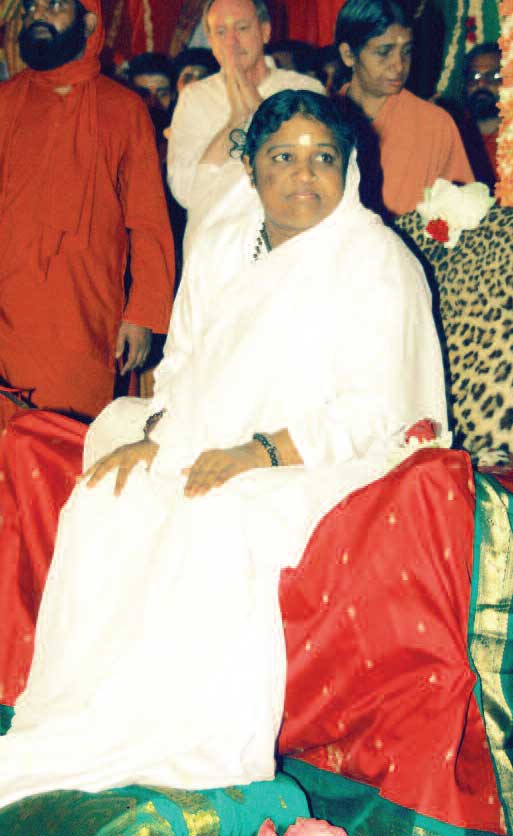
The Hindu spiritual teacher known as Amma (“Mother”), or Mata Amritanandamayi, was born to a family of fishermen in southern India in 1953. Today she is popularly known as the “hugging saint” for her practice of embracing all who approach her as she gives darshan, or an “auspicious sight” of a holy person. In addition to giving darshan, Amma heads a global foundation that sponsors numerous charitable and spiritual initiatives; in the States, her followers feed the homeless, provide visits to prison inmates, and aid victims of domestic violence.
Who or what is Amma? To the more disinterested she may appear as a saint or a guru, but to the majority of her followers and in her own understanding, she is a “Divine Incarnation” and manifests as “the Eternal Feminine, the Creatrix, the active principle of the Impersonal Absolute.” Yet Amma also believes that the Divine incarnates in us all. “Here,” she has stated, “is a crazy girl who puts on the garb of Krishna and after some time that of Devi, but it is within this crazy girl that both exist…. The Atman or Self that is in me is also within you. If you can realize that Indivisible Principle that is ever shining in you, you will become That.1 —The Editors
“I’m going to see Amma tonight” my friend Gretchen said.
I was surprised. The “hugging saint” was apparently real, and here in New York City.
“Can I go with you?”
“Amma sees everyone,” she said.
We set out together to the Jacob Javits Convention Center. I was expecting a more refined destination but Gretchen explained that there was no longer a ballroom big enough to hold the crowds of devotees and merely curious who wanted to experience Amma’s darshan, the ritual in the Hindu tradition of seeing and being seen by God. It was the last night of Amma’s North American tour.
Gurus and Masters have been coming from India to the West since Vivekananda in 1864. Amma is one of the most recent. She showed her spiritual destiny from early childhood and, despite her family’s opposition, devoted herself to the Hindu ideals of prayer, chastity, asceticism, and benevolence. She has been hugging devotees since the late 1970s. Though she apparently does not instruct her followers, the results of her embrace have been almost legendary. Schools have opened all over India and hundreds of thousands have been fed daily by her soup kitchens, among her many charities.

Rejecting the stifling conventions of her birthplace, Amma has based her beliefs, as well as her theology, on the early Vedic period when men and women were equal in society and in religious observance. Male and female forces were balanced in accordance with cosmic laws. But gradually the masculine energy began to dominate on earth, until the feminine force and women were devalued, then despised, and finally subjugated.
In Amma’s view a correction is necessary; her disciples perform all religious roles equally with women freely administering the rites and rituals of the Hindu faith. Amma’s tour staff of Brahmacharinis (ascetic disciples) and musicians, drawn from all faiths and ethnic groups, naturally treats men and women as equals.
Amma has written, “In India the Supreme Being has never been worshipped exclusively in masculine form. The Supreme Being is also worshipped as the Goddess in her many aspects…. Only love, compassion and patience—the fundamental qualities of women—can lessen the intrinsically aggressive, overactive tendencies of men.”2
Her own role, Amma believes, is to channel the universal Mother. She once said:
“The Servant of Everyone
Do you ask why the sun shines, or
the rivers flow?
It is Mother’s nature to love—
her embrace
Expresses that love.
An unbroken stream of love flows
from Mother
To every being in the universe.Mother does not give expecting
Anything in return.
What nourishes Mother
Is the happiness of her children.
Mother is the servant of everyone.
I have no home of my own—
I live in your hearts.”3
Amma’s dharshan celebrations are joyful occasions with music, dancing, chants, and the occasional showers of flower petals. And she never leaves until each devotee is hugged, even if that can take more than twenty hours.
We entered the stark halls of the Javits Center freely. No one stopped us or asked who we were or why we had come. The cavernous space, which seemed more fitting for a car or boat show than a dharshan, seemed mostly empty other than a cluster of people grouped around an elevated platform at the far end. Gradually I noticed a row of booths ranging the walls, with people selling Amma jewelry and books on Amma or offering Hindu astrology readings and the like. Temple chanting formed the aural background, alternating between recordings and a live orchestra seated on the platform. To our left, a temporary cafeteria offered vegetarian meals prepared by an army of volunteers. But we had already eaten and we were eager to find places for the darshan.
According to the young man holding a clipboard, our wait would be eight hours.
The rows of folding chairs stretched ahead of us, with a cross-section of New York humanity waiting their turn. Children ran up and down the aisles but nobody minded: they were also welcome. In fact Amma has a special fondness of children and will give them extra time and encouragement.
As it was already 8:00 P.M., we were due to have our turn at about 4:00 in the morning. Apparently Amma would continue her darshan hugging until everyone in the hall had had their turn. With lines on both sides of the room, it looked as if she would be there until at least six in the morning. On her last nights, before leaving a New York City tour, she often remains until 8:00 or 9:00 A.M.
Knowing that Amma made special exceptions for those with time constraints or physical challenges, Gretchen made her way to a line monitor and we were reassigned to a section of chairs where the wait was only two hours long.
We could see Amma only in occasional glimpses as people came and went. On TV monitors I could see short films of her life, showing her feeding and housing the poor.
Monks, acolytes, practitioners mingled on the platform, some leading the chanting, some helping the darshan seekers to take their places in the lines. We could have been in India, or in any one of the dozen cities in America where Amma gave darshan to anyone who came. Gradually we moved up in the line, and our view of the platform became clearer. Amma’s helpers, one on each side, would position the supplicant on a low stool in front of Amma so that she could lean down from the step above and embrace them. At some mysterious signal not visible to me, the helpers would ease the recipient back on her feet, and make room for the next one. Amma held some people longer, spoke to some, gaily hugging every type of New Yorker from suited Indians to Rastafarians, hip-hop kids in their hoodies and backward baseball caps to mothers with babies in their arms.
Throughout, Amma seemed completely relaxed and at ease. She smiled, chatted, sometimes laughed happily. There was no sense of strain or of fatigue.
The hours passed slowly though the music and chanting helped. Finally, it was my turn.
Her helpers thrust me into Amma’s arms, and I found myself half reclining on her flower-bedecked bosom. She said nothing, but leaned her face close to mine while I tried to be attentive to her contact. Then I heard a sound that emanated from her, the sound of an energy that was flowing through her to me, a purring rumble, soft yet distinct, as of a great motor humming. It was fascinating, and I would have liked to have known it longer, yet when Amma deemed I had received a sufficient “hug,” too soon it seemed to me, her helpers efficiently lifted me to my feet and then made way for the next in line. So it was not really so much of a hug, in the usual understanding of the word, but a contact with Amma that enabled the force she was channeling to reach me … and all the others she touched. To call it a “hug,” which symbolizes love, was the easiest way to explain her mission and to align it with her role as the loving mother of all beings.

The closest I have heard to the vibration that came from Amma was at a Hopi pueblo Corn Dance when two Hopi elders swung their Bull Roarers, rectangles of wood on eight-foot-long leather thongs, in a wide circles. The resulting thrumming vibration seemed to come from the Earth itself, hinting that what is above, can be heard by us below.
An apple and a chocolate kiss were thrust into my hand by a brahmacharini (devotee) as I walked away—they were from Amma. The apple went into my handbag, the chocolate kiss into my mouth, and its sweetness lingered for a long time after the chocolate was gone.♦
1 Amritaswarupananda, Swami, Mata Amritanandamayi: A Biography (Mata Amritanandamayi Mission Trust, 1988).
2 Mata Amritanandamayi, The Awakening of Universal Motherhood (Mata Amritanandamayi Mission Trust, 2003).
3 Janine Canan, Messages from Amma (Celestial
Arts, 2004).

